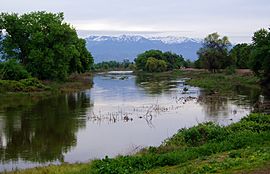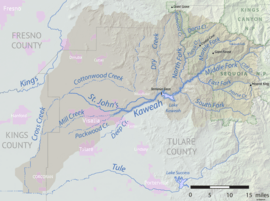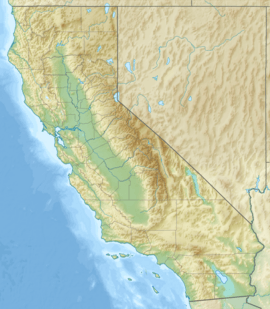St. John's River (California) facts for kids
Quick facts for kids St. John's River |
|
|---|---|

St. John's River near Visalia
|
|

Map of the distributary St. Johns River also showing the Kaweah River watershed
|
|
|
Location of the St. Johns River in California
|
|
| Country | United States |
| State | California |
| County | Tulare County |
| Physical characteristics | |
| Main source | Kaweah River Woodlake, East Visalia, California 279 ft (85 m) 36°20′12″N 119°13′23″W / 36.33667°N 119.22306°W |
| River mouth | Traver, California 279 ft (85 m) 36°25′05″N 119°26′05″W / 36.41806°N 119.43472°W |
| Length | 26.3 mi (42.3 km) |
The St. John's River is a special kind of river branch called a distributary. It flows from the Kaweah River in the San Joaquin Valley of California, USA.
This river starts at a dam near Lemon Cove. It then flows west, passing north of Visalia. Along its path, it joins with Elbow Creek and continues towards Cross Creek.
Contents
River's Journey and Use
The St. John's River plays an important role in the area.
Water for Farms
In the past, water from the St. John's River flowed into Tulare Lake. This lake was a "terminal sink," meaning rivers flowed into it but no water flowed out. Other rivers like the Kern, Tule, and parts of the Kings River also fed Tulare Lake.
Today, most of the water from these rivers is used for irrigation. This means it helps water crops on farms. The St. John's River provides water for many farms in Tulare County.
Where the River Flows
About 4 miles north of Farmersville, the St. John's River flows into Elbow Creek. From there, it moves west towards Cross Creek, north of Goshen. It then connects back to Elbow Creek where Elbow and Cross creeks meet. During times of heavy rain or floods, this water can still reach the Tulare Lake Basin through Elbow Creek.
History of the St. John's River
The St. John's River has an interesting history connected to the region's development.
How the River Got Its Name
The St. John's River was named after a person called Loomis St. John. This river branch actually formed because of a big flood that happened in 1862.
Water Management Changes
In 1889, a group called the Tulare Irrigation District was created. This group built many canals to move water from the river to farms. However, a lot of water was lost because these canals were not lined.
The 1906 Flood
In 1906, a part of the St. John's River's levee (a wall built to hold back water) broke. This caused water to flood into Visalia from the north, making the floods of 1906 even worse.


